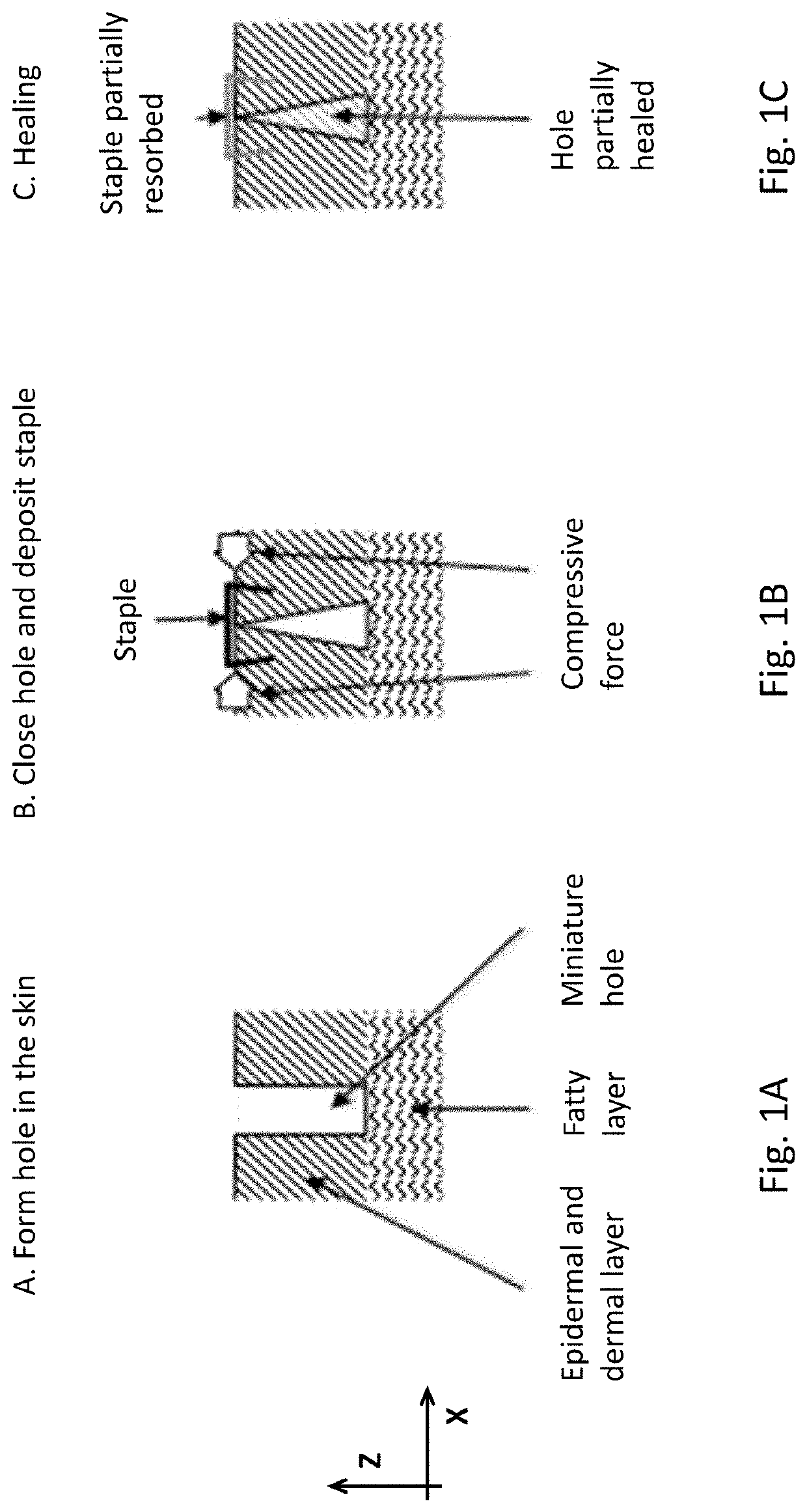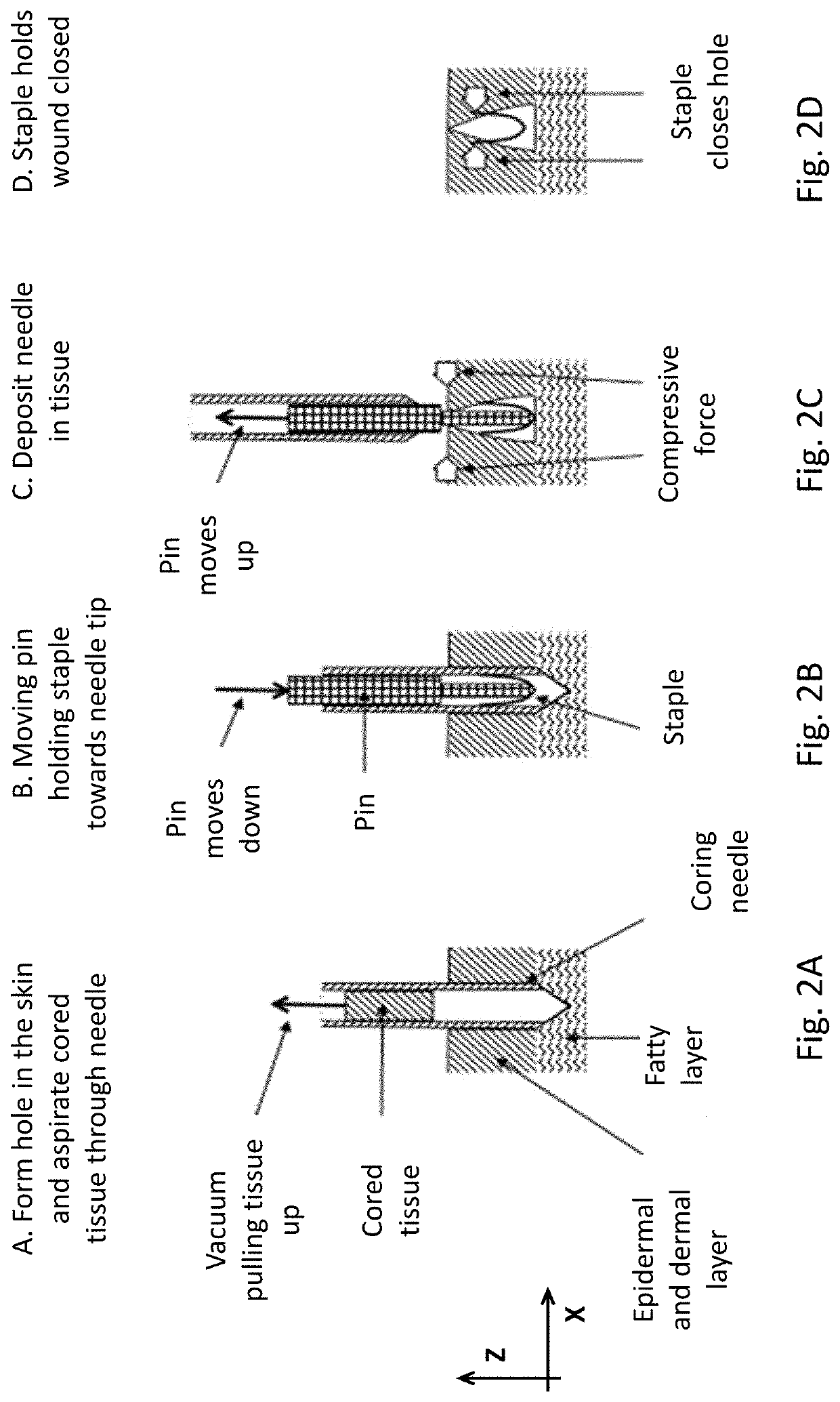Microclosures and related methods for skin treatment
a skin treatment and micro-closure technology, applied in the field of micro-closures, can solve the problems of scarring, invasiveness, inconvenient, expensive, etc., and achieve the effect of limiting the applicability of scarring, reducing the risk of infection, and reducing the effect of scarring
- Summary
- Abstract
- Description
- Claims
- Application Information
AI Technical Summary
Benefits of technology
Problems solved by technology
Method used
Image
Examples
example 1
Treating Skin Regions
[0244]A skin region can be treated by any useful method prior to affixing a microclosure. For example, this method can include forming a plurality of small holes or microwounds in the skin through the dermal and epidermal layer. Generally, the dimension of the holes is in the range of 50-500 μm in diameter. Without wishing to be limited by theory, it is envisioned that up to 40% of the treated skin surface (e.g., 10 to 20% of the skin surface) can be removed and that the amount of removed skin determines the extent of the tightening effect. The holes can be formed surgically, for example, by using a hollow coring needle (e.g., any described herein). Alternative forms of energy, e.g., such as laser, non-coherent light, radio-frequency, or ultrasound, can also be used to form the holes. The holes can be circular or have any other preferred shape (e.g., an elongated shape). After the formation of such holes, the methods and devices (e.g., microclosures) described h...
example 2
Microstaples (Method 1)
[0245]After treating the skin to form a plurality of microwounds in a skin portion, one or more miniature staples (or microstaples) can be used to compress the skin. Compression, staple deposition, and wound formation may occur in any order.
[0246]FIGS. 1A-1C describe an exemplary process. First, a microwound is formed through the epidermal and dermal layer. A compressive force is then applied to close the hole in a preferred direction. Without wishing to be limited by mechanism, the compression direction is aligned with the desired direction of tightening (e.g., parallel to the skin in the x-direction as shown in FIG. 1, or in any useful direction, such as in the y-, z-, xy-, xz-, yz-, or xyz-direction). A miniature staple is deposited in the tissue and maintains the hole closed for the duration of the wound healing. Without wishing to be limited by mechanism, this duration is sufficient for the formation of a closed epidermal layer and for formation of a new ...
example 3
Microdressings (Method 2)
[0254]The microwounds can be individually closed by miniature wound dressings (or microdressings). Compression, microdressing deposition, and wound formation may occur in any order.
[0255]FIGS. 7A-7D describe this method. First, a plurality of holes are formed through the epidermal and dermal layer. Then, the holes are closed by a compressive force applied on the skin, for example, by the same apparatus that created the holes. The compressive force closes the holes in a preferred direction. Microdressings are then applied on the closed wound and maintain the wound closed during the healing process.
[0256]Alternatively, the compressive force can be applied by a pre-stretched microdressing. FIGS. 8A-8D describe this process. The dressing is pre-constrained (pre-stretched) before adhesion to the skin. Then, an apparatus (e.g., a coring needle) is introduced through the epidermal and dermal layer to core tissue, thereby forming microwounds. A cylindrical component...
PUM
 Login to View More
Login to View More Abstract
Description
Claims
Application Information
 Login to View More
Login to View More - R&D
- Intellectual Property
- Life Sciences
- Materials
- Tech Scout
- Unparalleled Data Quality
- Higher Quality Content
- 60% Fewer Hallucinations
Browse by: Latest US Patents, China's latest patents, Technical Efficacy Thesaurus, Application Domain, Technology Topic, Popular Technical Reports.
© 2025 PatSnap. All rights reserved.Legal|Privacy policy|Modern Slavery Act Transparency Statement|Sitemap|About US| Contact US: help@patsnap.com



